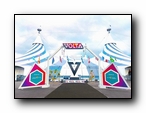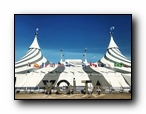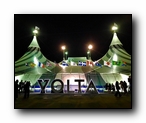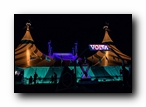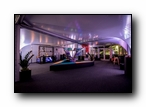
![]()
[ You are here: Grand Chapiteau | Creations | VOLTA | Scénographie ]
Création
Expérience
RéserveRetiré
Odyssey
Measuring 167-feet in diameter, the big top stands almost 57-feet high and is supported by four central masts, each 80-feet tall. A wall and supplementary upstage decking, directly behind the 41-foot diameter stage, displace about one-quarter of the usual 2,600 seats, limiting capacity to 2,000 in a 240-degree arc around the stage and transforming it into more of a thrust. A 5,000lb open-frame bridge, spanning the rear of the stage, glides up and down on vertical tracks mounted on the two upstage masts and serves as an additional staging and rigging platform. The Sky Grid, suspended from the four masts directly above the center of the stage, is accessible from a catwalk running from the upstage-left mast. Production designer Bruce Rodgers, who'd previously cut his teeth on massive stadium-sized stagings, was ready to shake things up for Cirque du Soleil when brought onto VOLTA. "We studied the 20 big top shows that Cirque had already created and saw that every one of them had held all the action within the confines of a 41'-diameter [stage]. We began working together in a small room that was painted black, so we could use chalk to sketch out ideas on the walls; we spent three weeks sketching various ways to solve the puzzle of the deck."
Some scenic pieces, including metal frames and six large polycarbonate BMX bike ramps, are constructed to fit inside each other, in the manner of Russian dolls, for more compact and efficient storage behind the wall. Rodgers adds, "We also used the wall to nestle two 164-sq.-ft. band shells, sunk 2' below the show deck— which are necessary because it's a live music show — and to contain the Cube that serves as our centerpiece." Emerging from behind a curtain in the center of the wall, the 13,000lb Cube is anchored to an automated tracking system, located in the deck, that moves it 25-feet downstage, rotates it on its vertical axis, and splays out two walls, hinged on opposite corners, to reveal an inner chamber. The two walls serve as oversized LED display screens for multimedia content, and the top surface is accessible via a concealed ladder and hatch for use as a supplementary mini-stage. The circuitry for the Cube's mechanical and electrical systems is on its own 200A supply, and the wallpaper on the backs of the walls is perforated with tiny holes to supply air for cooling the LED panels. "The wall panels are equipped with air brakes, and we have a readout on their position so that we can stop them at exactly the right angle," Fox says. "Under the Cube's floor panels are the motors that allow it to rotate and pockets for all the power, DMX control, and dimmers, as well as patch boxes for certain other things in the show that we need, such as networking. There's also a large igus cable spool underneath that allows the CAT6 cables to twist 360-degrees."
"We used the Cube less as a background surface and more as a monolith in a Stanley Kubrick kind of way," Rodgers says. "With a scrim surface on the back that allowed us to bleed light through to reveal what's going on inside, the Cube became a living portion of the design. That was one of our goals: We didn't want the scenery or the stage design to feel latent or dead or too black, but to have an energy to it. The lighting designer, Martin Labrecque, and I worked closely together to ensure that every scenic piece has either LEDs infused into it or lighting hidden within it." That's also true for the 38"-high stage itself, Rodgers says: "When you look at the history of big tops, they always have a fantastic scenic floor with a great look; the façade of the stage always has a character to it as well. Our concept for the stage was a granite quarry. Deconstruct that a little into blocks of granite, some of which are a bit crumbly and others of which are perfect 90° cuts that have been shaved and polished. Then sculpt these pieces together to make it look as if the whole stage foundation was mined from a quarry, and now let's infuse light into it. It looks a little broken, with cracks and fissures, and light spills through the hard granite and gives it a softness. The ‘granite' is a combination of heavy-duty vacuform and fiberglass on metal frameworks." In a first for Cirque du Soleil, three slim, articulated hydraulic lifts were incorporated into the center of the stage to raise and tilt sections of the floor up to 22' above the deck in order to accommodate several feats of physical prowess, including an extended trial bike-riding scene in which the rider scales numerous obstacles without setting foot on the ground. Each of the three lifts is equipped with four Chauvet Professional ÉPIX LED strips mounted on its sides, while on the base plate below the deck, six ETC 750W WFL PARs provide interior lighting that effects the softness within the granite. A lighting ring, populated with 32 Elation Professional ELAR Q1 LEDs, is set into the floor near the outer edge of the stage. "These lights can chase, tone, and give some footlight moments," Rodgers says. "The combination of hard and soft, real and imagined, was a major piece of the language, and having Martin be able to control and pulse light through the stage gave it a sort of heartbeat and endowed it with life." The outer edge of the stage is defined by a ring of three sets of LED tape that run under a diffusive Plexiglas covering and are spread across 22 DMX universes. "The groove for the ring is 3" wide by 1" deep," Fox says. "We're using RGBW tape at 144 LEDs per meter, with two LED strips on the outer edge and one LED strip on the inner edge. The ring is 38m long and includes 16,416 LEDs, excluding an additional 12 sets of ‘lava' LED tape running from the ring to the base of the stage facing." A 4.5'-foot wide donut turntable, located between the central lift area and lighting ring, is controlled by a TAIT Navigator system, as are the lifts, Cube, bridge, and elements of the grid. As in all big top shows, winches and hoists are floor-mounted under the bleachers, with lift lines running up over pulleys at the top of the masts and down to the loads. All equipment under the bleachers is covered during performances to protect it from spilled drinks, popcorn, and other detritus from excited spectators. Two booths are provided in alcoves in the tent wall for the automation console operator, stage manager, lighting console operator, and multimedia operator. The front-of-house sound position is in the seats, between the booths. For the mind-blowing BMX bike finale, the stage is transformed into a full-size roulodrome (skate park) in front of the audience's very eyes. Because of the limited space under the Big Top (the VOLTA stage is exceptionally deep) the six massive ramps used are of increasing size and slip one inside another, like Russian dolls, when stowed away. The ramps are made of thick, heavy-duty polycarbonate – a material used to make bulletproof glass – and are fully transparent so as not to block the view of spectators sitting in the front rows, who see riders hurtling directly toward them at white-knuckle speed and bouncing off the wall high over the stage. The material has to be strong and resistant, because a rider landing on a ramp generates a force of 12 Gs: twelve times his weight!
"From the beginning, I wanted the show to be very bright and built around light," says video content and interactive designer Thibaut Duverneix. He didn't want to use projectors though because first, they'd compete with the lighting design (in a space where every centimeter is needed for lighting, sound, and rigging, using projectors puts constraints on available space) and second, he would have to account for image instability as the performers moved about on stage. Therefore, the team decided to work with LEDs instead. "I wanted the whole place to be super-bright, and I also wanted great image quality—something that would be warm for the memories sequences featuring the cinematic footage that we shot. We had to go with a product that was high-end and, also, because the audience is very close to the set, something that would be sharp with a high pixel density and that afforded good viewing angles. It's invariably a problem that you get some bending artifacts if you look at it from the side. The tricky part was to find a partner to build the screens that would yield beautiful images with an organic feel. We had the 4mm LED displays, with a resolution just under HD — 1540 x 900 pixels — manufactured by Theatrixx Technologies in Montréal." Some 200 Chauvet ÉPIX Strip Tour pixel-mapping 0.5m LED strip fixtures, featuring 25 LEDs in a single row, and 26 ÉPIX Bar Tour pixel-mapping 1m LED bars, featuring 150 LEDs in three rows, are mounted around the stage, on the bridge and four masts, and at various other locations throughout the big top, says technical designer Olivier Gagnon. Duverneix and Gagnon customized a playback rig based on a Coolux Pandoras Box V.6 media and show control system, using Derivative TouchDesigner visual programming language, to achieve real-time interactivity of the content on the LED strips, 4mm Cube displays, and four small displays on the back wall, yielding a look that's never exactly the same from one show to the next. "As with the filmed elements," he continues, "we had the option of playing back the movies from Pandoras Box, or routing that output through TouchDesigner and applying real-time shaders on top of it, fragmenting the image, or creating other artifacts in real time. We were typically working with four layers, but on occasion we were working with up to 80 layers—the layering possibilities in TouchDesigner are limited only by the amount of processing power in the computers." Duverneix and his team shot the footage for Waz's childhood home movies with an Alexa camera and vintage Zeiss lenses from the 1970s. "They are beautiful lenses, very soft and creamy," he says. "When you stick them on a modern camera with a really sharp big sensor, they don't cover the whole sensor, so it gives you a kind of vignette. They're not exactly the same size as the sensor on the Alexa, which is 4K—actually 3.2K. But it was fine, because we were shooting square, so I just cropped it because the vignette was outside of my shooting zone. "With the system we developed, we take the live feed from three onstage cameras, add VFX on top of it in real time, and integrate it with the filmed elements and CGI being rendered simultaneously in response to various triggers from the other departments, thanks to the speed of OctaneRender's GPU-rendering. All of this is done in real time using TouchDesigner and some software we created with it."
Along with the multimedia extravaganza, the lighting design goes a long way toward establishing the overall atmosphere of VOLTA and creating the illusion that there's a live TV program in progress. But, as always, lighting is also tasked with highlighting performers and focusing the audience's attention on particular details. "It's a really weird process, because at Cirque we have to do a lighting design even before they start rehearsing, so we're spending $1 million to buy equipment for a show that we can see only on paper," Labrecque says. Regarding lighting positions, the four masts bear most of the load simply because, apart from the floor, there aren't many others available. "We can't hang much from the grid because there's a lot of rigging up there. On the bridge, I have only a few fixtures, because it's used as an acrobatic apparatus and it moves a lot. In any event, it's almost already at the maximum weight it can support, so most of the hanging is on the four masts." No more than a pair of ETC PAR MCM fixtures can be placed at each end of the bridge. "Also," he notes, "this was the first big top show to have video, and we're all fighting for places where we can hang." Each of the downstage masts includes a followspot operator position equipped with a Robert Juliat Lucy unit located about 24' off the floor. Some 12' above that are a Claypaky Scenius Spot and a pair of Claypaky A.leda BEYE K10s; higher still are six ETC Source Four PAR MCM fixtures with medium flood lenses, two at 40' and four at 42.5'; another two are hung 16' off the floor. Just under the spot operator platform are four ETC Source Fours with 36° field angles. The upstage masts are configured differently. Between 20' and 41' off the floor, two identical arrays are hung on the sides of each mast facing the stage: In descending order are a Scenius Spot, A.leda B-EYE K10, Ayrton MagicPanel-FX, and another A.leda B-EYE K10. This sequence is repeated, and, below that, at 18', is a pair of ETC Source Four PAR MCM fixtures with medium flood lenses, and, at 16', two ETC Source Fours with 26° field angles. On the upstage side of these two masts, two A.leda B-EYE K10s are hung at about 23' and 27'. Topping the upstage-right mast at 42.5' are six ETC Source Four PAR MCM fixtures with medium flood lenses. On the upstage-left mast, the corresponding six fixtures are hung a bit lower, out of the way of the catwalk anchored here. A Claypaky Mythos 2 hybrid light is hung at each of the cardinal points on the outside edge of the grid, with an additional Mythos 2 hung right in the center. "There's not much space to hang and we're all fighting for it. I need the beam mode and I need to be able to use gobos, too, so I didn't use [Claypaky] Sharpys because they do only one thing," Labrecque says, explaining the necessity of selecting versatile equipment. "We used [the Mythos units] a lot in beam mode, so we could structure the light." He also hung nine Chauvet Professional COLORado 1 Quad Tour LED wash lights upstage and nine downstage, on the grid, as well as a single ETC Source Four with 19° field angle under each end of the catwalk in the grid. Two small trusses, rigged on span guys over the rear seats next to the wall of the big top at stage left and stage right, each carry five ETC Source Fours with 19° field angles. For lighting behind the upstage wall, Labrecque hung eight ETC Source Four PAR MCM fixtures with medium flood lenses, spaced about 5' apart. Floor space around the deck is extremely limited. A slightly sunken shelf was built on each side of the stage in the angle where it fans out into the additional upstage performance space to accommodate a single Mythos 2 unit. A Claypaky Alpha Profile 1200 beam shaper sits atop each of the band pods, upstage left and right, while three Chauvet Professional Rogue R1 wash moving heads occupy the corners of the Cube's roof, and a fourth is centered on the truss under which the Cube rests in its default upstage position. Although Volta's lighting design is comparatively modest — with 40 moving lights— it does the job extremely effectively, hitting all the right notes and pumping up the already high energy onstage. Programming on the MA Lighting grandMA2 console was by François Marceau, the project manager for lighting was Annick Ferland, and Kareen Houde served as the lighting assistant. Integral to the scenic design are 22 "lampposts" shaped like inverted hockey sticks, six of which are deployed in several locations around the stage throughout the show. Each of the 16 fixed lampposts sports either one Épix Tour Bar or one ÉPIX Strip Tour LED strip under the upper short angled arm and, depending on the post's height and width, either two Épix Tour Bars or three ÉPIX Tour Strips on the vertical portion. The movable lampposts are fitted with generic RGBW LED strips and are battery powered, using a custom wireless system. Each lamppost is spiked into a corresponding anchor in the stage about 1.5" in diameter and 8" deep. "We use a total of 27 EPIX Drive 900s to control the whole system," Fox says. In addition to the lights built into the stage, a noteworthy lighting feature is the prop cell phones that entrance the Greys with their eerie ultra-white glow. Studded with white LEDs around the edges, these self-contained, battery-operated devices were designed and manufactured for the show by Inventions Guite Inc., of Montreal. Together with Waz's laser-adorned coat—a development of the costume designer Zaldy Goco's model for Michael Jackson's This Is It Tour that never was—they constitute a extension of the use of light into other departments. Rounding out the lighting gear list are two Elation Professional Protron 3K LED strobes. Also used are four Ultratec Special Effects Power Fog Industrial 9Ds, three Ultratec Premier Fog Effects Generators, two Look Solutions Tiny CXs, one Look Solutions Viper, one Martin by Harman Jem Glaciator X-Stream, and two MDG Atmosphere APS haze generators.
Volta is propelled by a non-stop, high-energy music score composed by Anthony Gonzalez, the single full-time member of the electronic music project M83. Shifting from atmospheric soundscapes to rhythmic urban pop and soaring symphonies rich with orchestral-sounding synthesizers, Gonzalez's highly cinematic score evokes a range of moods that flow with the unfolding narrative. Always in sync with the acrobatic performances, the score is also tightly synchronized with the lighting effects, thanks to the interactive responsiveness of the multimedia design. The score is played mostly live by a four-piece band with two onstage vocalists. The female vocalist occasionally doubles on electric violin. Offstage, the band is divided in half, with two instrumentalists in each of the upstage band pods. To the left are the band leader, playing keyboards and doubling occasionally on sax and electric bass, and the drummer. The band leader also operates an Ableton Live software music sequencer. The second keyboardist and guitar player, in the opposite pod, join the cast onstage on several occasions. One electronic keyboard controller used by the band is the unique and very expressive Roli Seaboard. While the keys are laid out in the conventional piano sequence, the entire keyboard is covered in a continuous surface of pliable silicone. In place of the usual control wheels for modulation and pitch bend, the player executes these effects by moving fingers up and down over the pliable surface, holding keys down while vibrating the fingers to achieve vibrato, for example, or moving the hands sideways along a strip below the keys to effect pitch bending. Gonzalez has taken advantage of the innovative way that sounds that can be modified using the Seaboard to the point that it seems inconceivable that Volta's score could be accurately executed without it. "We have stereo synths, stereo drums, stereo bass, stereo guitar, stereo extra vocals, and 32 outputs of Ableton Live coming back to the front-of-house and monitor consoles, so that we can separate all the audio," says the sound designer Jean-Michel Caron. "We also have a few inputs for special effects. If we want to have something move around, we can put it in the Space Map and have those sounds dance around the big top or any speaker we want." These spatial effects are executed from a D-Mitri matrix system with a 32-fader control surface at the front-ofhouse position, through a sound reinforcement-system centered on the masts, with subs beneath the stage, and surround and ambient loudspeakers hung in six locations near the curved wall of the big top. Because of weight restrictions, powered loudspeakers were ruled out. "We're using a d&b audiotechnik passive loudspeaker system," Caron explains. "While Meyer has been a great speaker for us for a long time, we ran into a problem with the weight. The d&b passive speakers are very light, and that allows us to put more speakers on each mast to achieve the coverage we need. The amplifier racks are under the bleachers on the floor, with four amplifiers for the loudspeakers on each mast." Each upstage mast is rigged with a matching complement of six loudspeakers, angled to provide optimal coverage to all seats, including: two Vi7P three-way point-source loudspeakers, one 12S biaxial two-way narrow-coverage loudspeaker, one 12S-D biaxial two-way wide-coverage loudspeaker, one E6 two-way compact coaxial loudspeaker, and one 8S two-way compact coaxial loudspeaker. Similarly, each of the downstage masts is rigged with a matching loudspeaker complement that includes two 12S, two 12S-D, one E6, and three 8S units. The subs under the stage are offset from the center by about 6', "just to clear the track of the Cube," Caron says. "I've got three subs, rear-firing in cardioid pattern, which is the perfect pattern for the big top. This way, it's one pointsource for the subs. There's no addition or cancellation due to multiple [spaced] sources. The bass is awesome." For front fill, fourteen 4S lightweight two-way coaxial loudspeakers are mounted on the inside of the façade panels, more or less evenly spaced around the 240° arc of the stage facing the audience. Above the stage, two 10S twoway narrow-coverage loudspeakers are hung on each side of the grid, together with a single 10S-D two-way widecoverage loudspeaker at the downstage center of the grid. The designer chose six positions near the wall of the big top to rig the surrounds: "There's a funicular where they pull back the tent to get the tension; we hang speakers from there and pull them back a little bit, so they get closer to the canvas wall and about 20' over the audience's heads. We use two speakers in each position: one 10S-D facing toward the stage, and one smaller 8S speaker facing toward the tent. It hangs behind the larger surround speaker and is focused directly to the canvas. I'm using the canvas as a deflector, so I can use that speaker to do effects when I don't want to hear the source clearly defined." To support distant-sounding effects emanating from the front, Caron installed a pair of 10AL-D biaxial wide-coverage line array modules just in front of the upstage wall, one atop each of the band pods. All amplifiers are d&b audiotechnik four-channel models, including two D80s, eight 30Ds, and four 10Ds. In the case of the lip fills, the loudspeakers are doubled-up, two to an amp channel.
Monitoring is provided only for the musicians. A DiGiCo SD9, in the tiny "doghouse" backstage, serves as the monitor console, with the mix being delivered via a wireless Wisycom in-ear monitoring system. The analog mic and DI outputs are split via a custom Radial Engineering Convertible V12 modular snake system and fed to the analog inputs of the front-of-house and monitor consoles. The AES/EBU digital outputs from the Wisycom MRK 690 wireless-microphone receivers are converted to Dante network audio via a Focusrite REDnet D16 interface and routed along with the outputs from the drum and keyboard samplers and Ableton Live software sequencer via the Dante network to both consoles.
The target sound pressure level for Volta is 97dB, but it seems much louder. The fact that peaks reach only 105dB SPL is, perhaps, indicative of a generous amount of compression and peak limiting that increases the perceived loudness. Wired and Tempest wireless systems from Clear-Com are used throughout, with noise-cancelling closed-cup headsets from David Clark provided for followspot operators seated up on the masts. The cue light system is from Leon Audio, with GDS BlueDomes for the blues system. While big top shows have relied extensively on generator power in the past, "We're using city power in Toronto, and in general we're leaning more toward that vs. generators for its lower environmental impact and because it is cleaner power," Fox says. |


